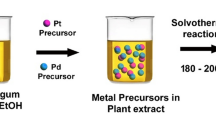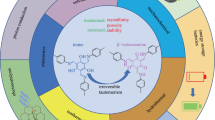Abstract
We have investigated some anodic and cathodic transformations using boron doped diamond (BDD) electrodes. The oxidation of a propargylic alcohol as well as the aromatic side chain oxidation in water as electrolyte did not␣yield the desired products in high yield and selectivity and led mainly to the formation of CO2 due to␣electrochemical incineration of the starting material. With methanol as electrolyte, however, the reactivity of BDD electrodes is similar to graphite in most anodic methoxylation reactions, but the inactive behaviour of BDD electrodes leads to a different reaction pathway possibly involving methoxyl radicals with charge transfer from the electrolyte. It has been found that at BDD anodes benzylic single and double bonds can be split yielding aromatic acetals and esters. With phenanthrenes as starting material, o,o′-disubstituted biaryls were obtained. So the use of BDD electrodes provides an efficient and environmentally friendly access to this interesting class of compounds. The high H2 overpotential of BDD cathodes enables smooth and selective reduction of functional groups like oximes. Due to the high chemical and mechanical stability of the diamond layer of today’s electrodes, electrode lifetime as well as reproducibility of the electrosyntheses has improved markedly. Aqueous basic conditions, however, must be avoided for BDD anodes. These conditions result in degradation of the diamond surface.
Similar content being viewed by others
References
M. Fryda, Th. Mathée, S. Mulcahy, M. Höfer, L. Schäfer and I. Tröster, in ‘The Electrochemical Society Interface, Spring 2003’, (2003), pp. 40–44 and references cited therein
Michaud P.-A., Mahé E., Haenni W., Perret A., Comninellis Ch. (2000) Electrochem. and Solid-State Lett. 3: 77
Janssen L.J.J., Blijlevens M.H.A. (2003) Electrochimica Acta 48: 3959
Saha M.S., Furuta T., Nishiki Y. (2004) Electrochem. Commun. 6: 201
P.-A. Michaud, Ch. Comninellis, W. Haenni, A. Perret, J. Niesta, M. Fryda and L. Schaefer, in ‘Electrochemical Society Proceedings’, Vol. 2001–23 (2003), pp. 87–96
European Patent EP 1 036 861 B1 (BASF AG)
German Patent DE 103 13 169 A1 (Degussa AG)
Zollinger D., Griesbach U., Pütter H., Comninellis Ch. (2004) Electrochem. Commun. 6: 600
Zollinger D., Griesbach U., Pütter H., Comninellis Ch. (2004) Electrochem. Commun. 6: 605
Canizares P., Diaz M., Dominguez J.A., Garcia-Gomez J., Rodrigo M.A. (2002) Ind. Eng. Chem. Res. 41: 4187
Iniesta J., Michaud P.-A., Panizza M., Comninellis Ch. (2001) Electrochem. Commun. 3: 346
Marselli B., Garcia-Gomez J., Michaud P.-A., Rodrigo M.A., Comninellis Ch. (2003) J. Electrochem. Soc. 150: D79
Zollinger D. (2004) Electrochemical Reactions at Diamond Electrodes in Aqueous and Non-aqueous Solutions, Diploma thesis. Swiss Federal Institute of Technology, Lausanne
Loyson P., Grouws S., Zeelie B. (2002) S. Afr. J. Chem. 55: 125
Shono T., Matsumura Y., Inoue K., Iwasaki F. (1986) J. Chem. Soc. Perkin Trans. I: 73
Martin H.B., Argoita A., Landau U., Anderson A.B., Angus J.C. (1996) J. Electrochem. Soc. 143: L133
9 was prepared by Friedel-Crafts acylation of benzene with 4-chloro-butyryl chloride (W.J. Close, J. Am. Chem. Soc. 79 (1957) 1455) followed by oximation (H.G.O. Becker, R. Beckert, G. Domschke, E. Fanghänel, W.D. Habicher, P. Metz, D.Pavel and K. Schwetlick, Organikum, Organisch-chemisches Grundpraktikum (Wiley-VCH, Weinheim, 2001), 675 pp)
(a) V. Wolf, Chem. Ber. 87 (1954) 668; (b) J. Kaulen and H.J. Schäfer, Tetrahedron 38 (1982) 3299
US patent 5 002 641 (Reilly Industries, Inc.) and references cited therein
E. Steckhahn and C. Kandzia, Synlett (1992) 139
DeClements R., Swain G.M. (1997) J. Electrochem. Soc. 144: 856
Acknowledgements
Financial support from the BASF AG is gratefully acknowledged. The authors thank Philippe Rychen and Werner Haenni (CSEM SA) for helpful discussions, Heidrun Machwirth, Michaela Kimmel and Volker Steuer for technical assistance and Dr. Harald Winsel (all BASF AG) for providing oxime 9.
Author information
Authors and Affiliations
Corresponding author
Additional information
⋆Dedicated to Professor G. Kreysa on the occasion of his 60th birthday.
Rights and permissions
About this article
Cite this article
Griesbach, U., Zollinger, D., Pütter, H. et al. Evaluation of boron doped diamond electrodes for organic electrosynthesis on a preparative scale⋆ . J Appl Electrochem 35, 1265–1270 (2005). https://doi.org/10.1007/s10800-005-9038-2
Received:
Accepted:
Published:
Issue Date:
DOI: https://doi.org/10.1007/s10800-005-9038-2




